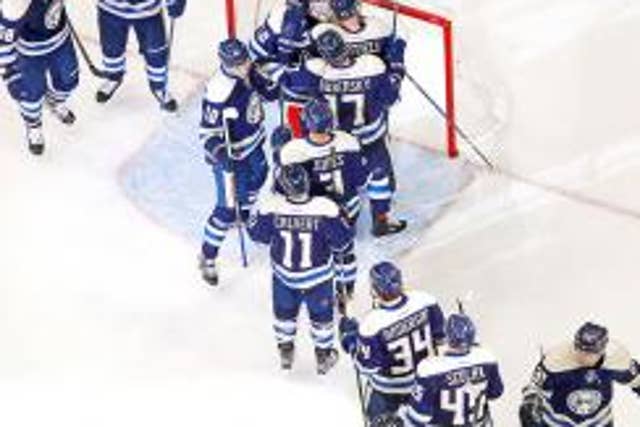
Nick Foligno getting comfortable in second season as Blue Jackets' captain
COLUMBUS, Ohio – There are several seating options inside the Blue Jackets’ family lounge: A circular dining table near the door, a couch angled toward the television, and a pink-painted, child-sized play set that looks perfect for sipping invisible tea. For a twenty-minute interview after Columbus’s morning skate last Saturday, the couch is probably too casual. And with two children now, Nick Foligno jokes, his 6-foot, 205-pound frame already lowers into enough tiny furniture at home.
He’s a natural conversationalist. Just watch those Papa Johns ads that play during television timeouts on the Nationwide Arena video screen, which actually require a surprising range of emotion. In one, Foligno fumbles to fold pizza boxes while wearing his hockey mitts; when a supervisor suggests he drop the gloves, he repljes, “Are you sure?” In another, he promotes a deal to benefit the Janis Foligno Foundation, named after his mother who died of breast cancer in July 2009.
Those were hard times, and through the years Foligno has encountered plenty. Two weeks after daughter Milana was born Oct. 14, 2013, she had life-saving surgery to fix a congenital heart defect. According to ESPN, only 16 children had ever before needed the type of procedure as Milana did, and only one as young as her. But it was successful. She requires regular checkups now, but is otherwise healthy.

“A typical 3-year-old bossing around her brother,” Foligno says of Landon, born Aug. 26, 2015. “I laugh with him, because I’m like, ‘Toughen up!’ She just runs the show. It’ll be good for him in the long run.”
***
Looking back, last season has certainly proven good for Foligno in the long run. That he and the first-place Blue Jackets have since rounded the corner makes it easier to reflect. “You can see the way he’s playing,” says John Davidson, president of hockey operations, “he’s free now.”
Two days ago, the Blue Jackets’ 16-game winning streak, second longest in NHL history, fizzed 5-0 against Washington. They would drop two of the next three, too, including after blowing a three-goal lead against the Rangers in the third period. During that stretch Foligno will provide the only relief, an overtime goal Sunday vs. the Flyers. It was his 14th this season, two more than he had in all of ’15-16.
But damned if everything from '15-16–starting 0-7, seeing the head coach fired, finishing in 27th place, altogether cratering on expectations—didn’t completely stink while it was happening. “It was tough,” he says. “You feel responsible. I was really disappointed in myself, but then you have to get over that. You have to get over those things, because the league’s not going to wait for you. Nobody’s going to wait for you. Nobody’s going to feel sorry for you. Get over it and find a way. It seemed like it took the whole year to find my way through it.”
Try to understand the loops in the roller coaster: In May 2015, coming off a career-high 73-point, 31-goal season, Foligno was named the Blue Jackets’ sixth captain in franchise history. This came five months after he signed a six-year, $33 million extension, and four months after he had captained one of two All-Star teams when Columbus hosted the game. (During the draft, Foligno memorably announced a trade—“I’ve always wanted to do this,” he said—of ex-Bruins castoffs, Phil Kessel for Tyler Seguin.) No Columbus player had worn the C since Rick Nash was traded in 2012, and management had its reasons for keeping the letter unstitched. “We didn’t feel we wanted to give it to someone who didn’t deserve it,” Davidson says.

Which is to say that the organization eventually believed Foligno did. In retrospect, this put an immense strain on a first-year captain when the ship took on water. As Foligno fretted about plugging every hole, the Blue Jackets believe that as a result he ignored himself. “He was so worried about everyone else, worried about guys who were struggling and trying to help the other guy out, which is awesome,” says forward Cam Atkinson. “But I think there was so much pressure. So much pressure.”
Foligno was far from alone. Atkinson was scratched during ex-coach Todd Richards’s last game, when the Blue Jackets fell to 0-7. Forward Ryan Johansen, the No. 4 pick in the 2010 draft, was traded for defenseman Seth Jones shortly after the calendar turned. Goalie Sergei Bobrovsky struggled with injuries, making just 37 starts and posting his lowest save percentage (.908) since coming to Columbus in June ’12. “I just felt like I took a huge step back,” Foligno says. “We all took a huge step back.”
Indeed, he had scored one goal through the end of November, and seven of his 12 came in three of 72 games. His shooting percentage (8.1) dipped well below prior career average (12.4), but it was hard to mine small positives from such a whopping setback. Even worse, Richards’s replacement, John Tortorella, began challenging Foligno’s position atop the leadership pyramid.

“I told Nick, ‘I’m not so sure, I don’t think you can do it,” Tortorella says. “I think that was my last thing I said to him before I left for the summer. It may seem weird. You may say, ‘Why did you say that?’ But I wanted to put the cards on the table for him. It’d be unfair for him not to know. I wanted to give him every chance at it. I needed to be totally honest with him. He didn’t do anything wrong last year. He didn’t understand how to do it.”
***
It was while attending the 2016 world championships in Russia with Team USA that Foligno first began noticing change within. As a team the Americans finished in fourth place, losing 4-3 to Canada in the semifinals, but Foligno individually felt revitalized. A devout Catholic, he took pleasure in touring the churches of St. Petersburg, drinking in the architecture. He also enjoyed exploring Russian history and culture in museums.
“I learned about Leningrad,” he says, without any prompting of what he had taken away. “Didn’t know about that. Ignorance on my part, probably. Just the pain they when through during that time. All you hear about is us and World War II and how we saved the day. You don’t realize the people who were affected, surrounding the city of St. Petersburg, starving those people. You gain an appreciation for other people’s cultures too, which is pretty amazing.
“It was a perfect way for me to go into the summer, really had a fun time. That excitement, that hunger to play, I was really excited to put that into training and come back and make a statement, that I could be a good leader for this team. More important than all the leader stuff was just being a good player. I felt like I let that slip. I think guys knew that I cared and all that stuff, but you can only do so much unless you’re doing it on the ice consistently. I was happy to get back and refocus on that for me, personally and selfishly, and carry that through.”

Selfish. Tortorella uses this word too. "That may sound weird, but he’s worrying about his play more this year," Tortorella says. In other words, handle your business before worrying about others. “I think he made me realize that,” Foligno says. “When you’re going through it, you’re trying to keep everyone together. You know you have a special group. That’s tough when you’re doing too much the other way. I didn’t play well enough. When you’re trying to hold everyone together, it’s like, ‘What are you doing to help us? Not instinctively, they’re just doing it like, ‘Hey, pull your weight too.’ And I wasn’t. I didn’t want to have any excuses happening. That was on me. I’ve got to worry about myself, then if I can do that, I can lead through that.”
The results indeed align with change. Foligno added more cardio to his workouts over the summer, hoping to shed weight, get faster, and pass Tortorella’s two-mile, 12-minute fitness test. Through Tuesday’s 5-3 road loss to Carolina, Foligno sits two points shy of matching his point total from last season (37). He scored zero power play goals in ’15-16; on the top unit now, alternating between the goal line and net front depending on where the puck has moved, he has seven. His average ice time has increased to 18:28, up more than a minute and a half. Skating with Brandon Saad and rising center Alexander Wennberg, his shooting percentage has almost doubled (8.1 to 15.7), and his even-strength shot attempt differential remains above 52%. “He’s proved a lot,” GM Jarmo Kekalainen says.
Of course, Foligno isn’t exactly turning his nose up at teammates, either. Davidson says that Foligno has started coming into his office more often, just to chat with the former NHL goalie. “I listened to his thought process, which from my point of view was perfect,” says Davidson, declining to add specifics. “I was so happy to hear what he was saying, I told him I’d do a cartwheel but I’d kill myself.”
Internally, the Blue Jackets rave that Foligno fought St. Louis heavyweight Ryan Reaves in November. (“Reaves ran one of our guys,” Davidson says, by way of explanation.) After Columbus started 0-2, the highlight of a five-day break that followed was an indoor go-kart trip organized by Foligno to a local track. When rookie defenseman Zach Werenski first reported to training camp, among his first conversations was with Foligno. Whatever Foligno said made such an impression that Werenski later told former Blue Jackets enforcer and Fox Sports Ohio analyst Jody Shelley, “It immediately settled me. Made me feel like part of the team.”
Nick Foligno, Columbus captain. Now there’s a chair that fits.
